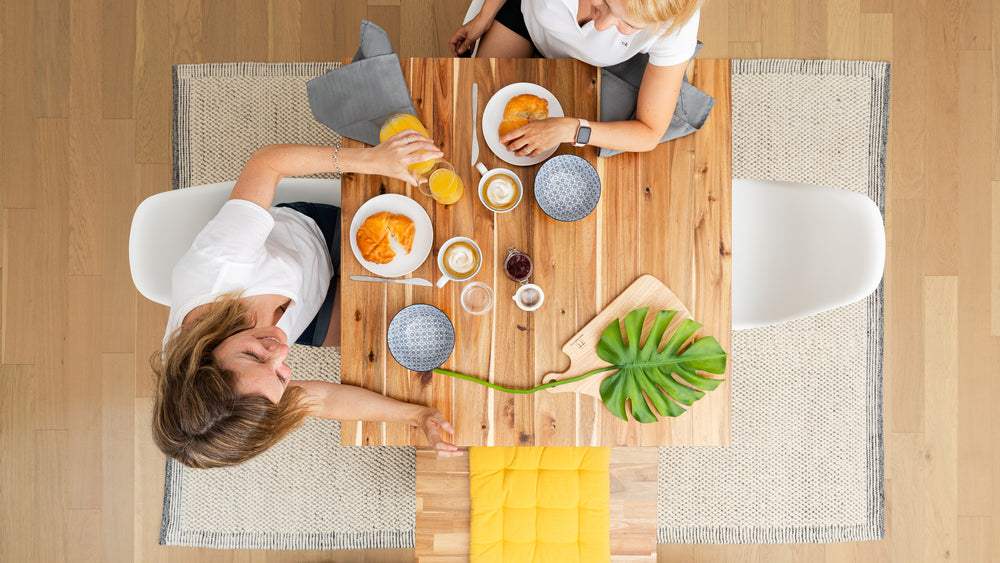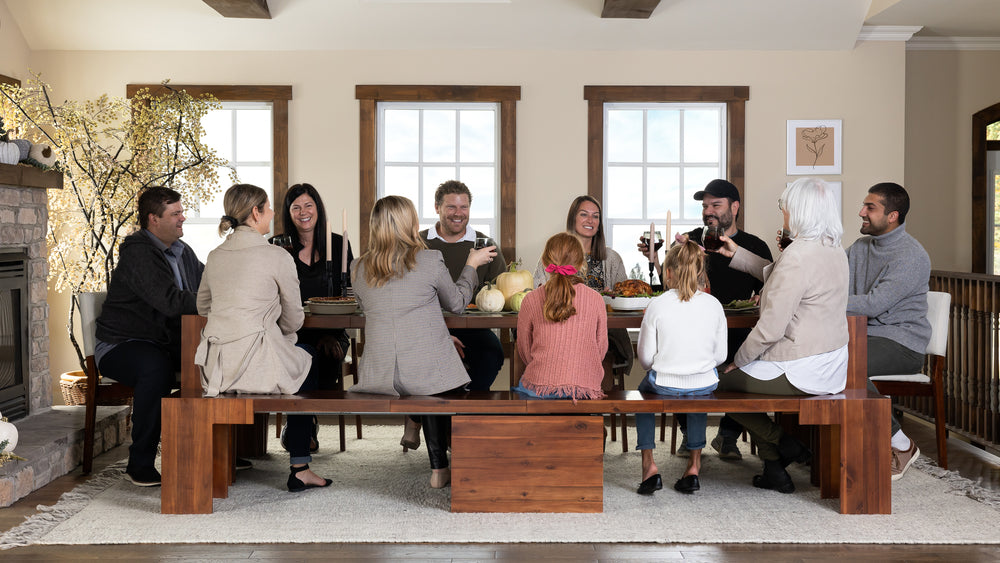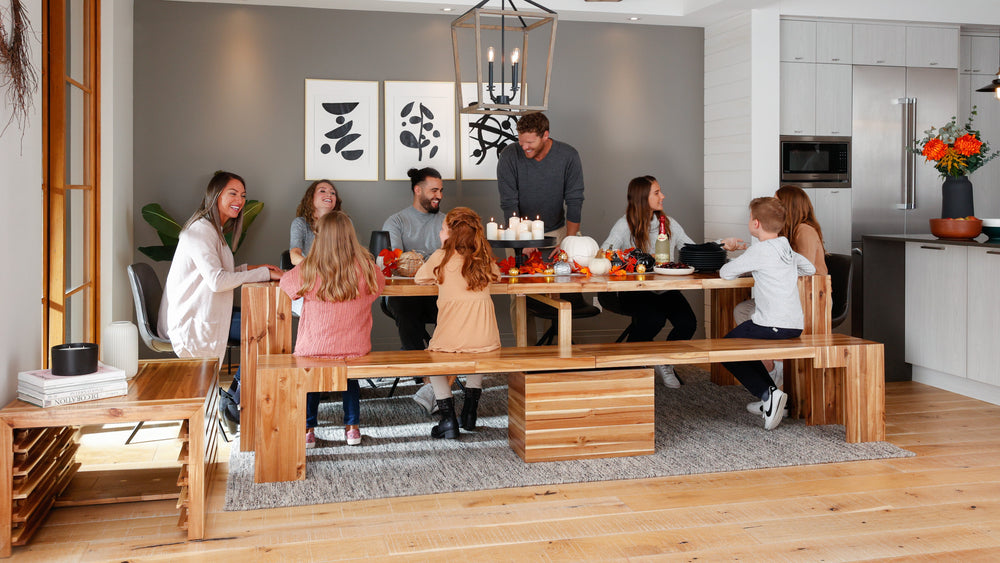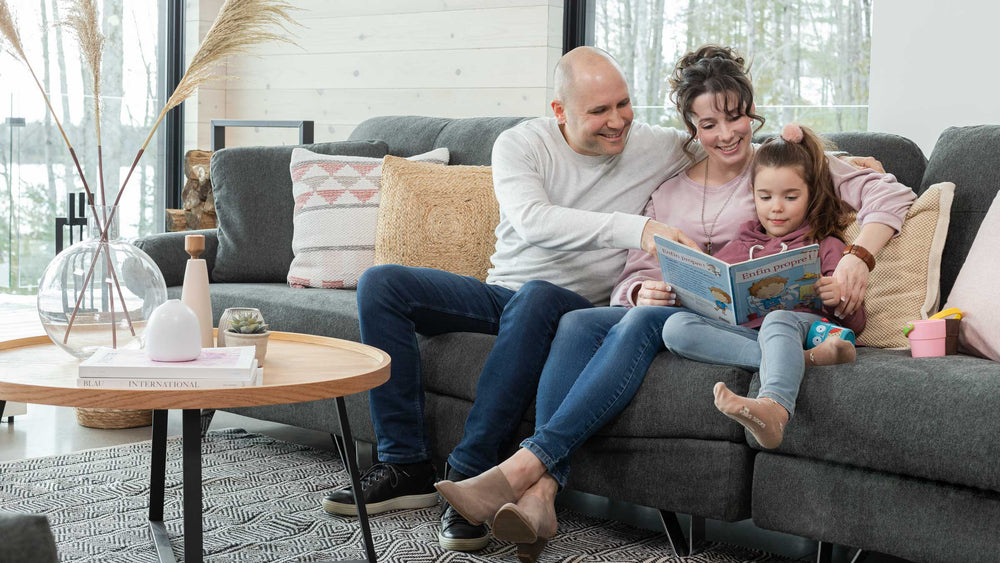
Best Types of Wood for Furniture

May 02, 2024
Ever wonder what sort of wood type would be best for a sturdy dining table or how to bring out the natural beauty in contemporary coffee tables? Let's find out!
Different Types of Woods For Furniture [Guide]

Types of wood for furniture include Oak, Maple, Pine, Teak, Birch, Cedar, Beech, Elm, etc. But with an overwhelming range to choose from, how do we narrow that down to choose the perfect wood for our furniture?
What's the difference between hardwood and softwood?

The key difference in wood furniture is down to hardwood furniture vs softwood furniture.
Softwood trees are first and foremost lightweight wood, meaning they would be easier to handle and move around than solid wood furniture. They're relatively less expensive than their hardwood siblings.
Softwood is coniferous meaning they originate from evergreen trees and can stand to be in cold, dry areas. The color of softwood is light, so if you're into a lighter aesthetic for your space this would be a good choice and their annual rings (growth rings) are distinct making for interesting texturing in your furniture.
There are some downsides to using softwood as opposed to hardwood, in that it's more flammable and while softwoods have good tensile strength, they're weaker in terms of shear strength - meaning this particular type of wood would be prone to cracks, knots, and faults when cut.
This sort of wood is considered weaker and less durable in general compared to hardwood counterparts - it's also prone to absorb water like a sponge so care is necessary when handling any liquids over the furniture.
Hardwood trees are more solid and heavier to move and handle during the furniture-making process.
Hardwood, due to its durability and other qualities which we will get into in a bit, is more expensive to both buy and produce.
Darker shades are more prevalent in hardwood furniture (although you may find lighter shades such as Maple wood for example) with annual rings more indistinct and close-knit, making for a more refined appearance in your furniture.
The greatest attributes are hardwood's durability and strength, with both tensile and shear strength your furniture will be resistant to cracks, and tears when cutting and able to support a considerable amount of weight without breaking - with added resistance to flames.
The downsides of hardwood lie in its expensive production and purchasing cost and can be a difficult wood to work with due to the sheer density of the wood and not all hardwood types are suitable for furniture production.
What are the Different Types of Wood Furniture?

In furniture making, there are three types of wood f furniture; solid wood, particle board, and plywood. We will dive deeper into the intricacies and differences between these categories.
Why do woods have different natural colors and grains?
Since wood evolves, the color of wood also darkens with age. Color can also be affected by natural lighting and how each type of wood reacts will vary.
You may also use finishes to add artificial color to your wooden furniture, each wood reacts differently to different finishes, even lighter and transparent, due to the natural differences in the wood color.
To identify if the grain color is natural or artificial, you can sand the ends. Other identifiers of wood include odors and fluorescence.
In terms of the pattern of the grain, there are differences between hardwood and softwood, namely, hardwood has an open pore structure, meaning the grain appears more pronounced, while softwood has a smoother texture due to there not being any visible pores (pores are more compact and tight).
How to Identify Types of Wood
There are several ways of identifying wood, as we have briefly mentioned a few of them. Now let's take a more in-depth look at wood identification :
Solid wood is identified by the end grain - growth rings that match up with the direction of the grain along the face of the wood. A cross-cut would also show, whether the solid wood is comprised of wood chips or 100% solid.
Question yourself about the wood, What is the pattern? Is the grain texture open or porous? Visually inspecting wood can be good for small indicators between staining and weathering, weight and rigidity, etc., but not entirely accurate so it would be best to send a piece to a professional lab if your budget allows.
Using your hands, you can feel the texture and hardiness of the wood, hardwood tends to be heavy and softwood is on the lighter side.
Also, take into account the moisture content of the wood as this can account for a percentage of the wood's total weight (if the wood was felled from trees in an exceedingly humid environment). The opposite comes into play if the wood was felled and stored in a relatively dry environment, the wood would most certainly feel lighter.
Freshly sanded wood will ensure that the wood is in its most natural state as wood darkens with age and staining prevents you from assessing the unaffected qualities of the wood.

Most Popular Types of Solid Wood for Furniture
Solid wood is the most popular, touted for its durability and exquisite quality. Here are the most popular types of solid wood furniture :
Oak - Oak is considered to be one of the pricier types of wood furniture but boasts quite a variety of colors. Also one of the more durable and hardier wood types, this makes it an excellent choice for homeowners who would have classic furniture for decades to come and requires more forethought before
Oak is naturally long-lasting so you could make virtually any furniture fit to last. Visually Oak has wavier grain patterns and knots and comes in black, red, and white hues to suit your interior style.
purchasing - if you are someone who moves frequently, this type of wood is quite heavy compared to other woods you may wish to consider a lighter wood.
Acacia - If deep browns that evoke a sense of warmth in your furniture are your jam, then Acacia wood may be just what you're looking for! Prized for longevity, durability, and water resistance, Acacia is perfect for bathrooms and kitchens.
Say goodbye to fungus, warping, and nicks and scratches! Naturally smooth and whether polished or in its natural state, and with grains ranging from medium to coarse and straight to wavy, Acacia is sure to add richness to your home.
Rosewood - For good quality and long-lasting furniture, Rosewood is an excellent choice for most homeowners since Rosewood is touted for its strength, hardness, termite resistance, and fragrance, and is low-maintenance.
Rosewood furniture has a luxurious look and feel, the grain pattern can be wavy, interlocked, or spiral, and due to the rosy brown hue - it makes for a timeless piece of hand-carved furniture.
Teak - Teak wood furniture is commonly used for outdoor furniture (specifically patio furniture) owing to being the hardest, most durable of the hardwoods.
Teak contains a natural oil repelling it against water, cracking, and warping which makes Teak the best wood for furniture in snowy, rainy, or extremely hot environments.
Fresh Teak starts with a honey-hue, that slowly turns to a beautiful grey color, and while outdoor Teak furniture needs no varnish or paint, if you'd like a more showy luster to your Teak then a natural Teak sealer will do the job just fine!
What are the most common types of wood you're likely to see at home?

The most common types of wood in the home are usually solid woods :
-
Oak
-
Teak
-
Maple
-
Mahogany
-
Rosewood
One should also take into account engineered wood and manufactured wood since furniture making often involves these types of composited wood furniture due to the availability and price of these convenient hybrid wood types. Engineered and manufactured wood types are as follows:
-
Plywood
-
Particle board
Benefits of Solid Wood for Furniture Making
One would think that solid wood only encompasses hardwood, however, both softwood and hardwood are classified as solid wood and the only other category of timber for furniture making would be engineered wood.
Solid wood is a far superior choice, as it's considered real wood and suitable for long-lasting, quality furniture with various aesthetic choices (color, grain pattern, weathering, distressing, carving, etc.) to go with any interior, or exterior in the case of outdoor furniture.
Solid wood is also more suited for the environmentally conscious buyer and furniture maker, as engineered wood often contains harmful chemicals during production and some months after, and cannot be recycled so any manufactured furniture automatically goes to the landfill. Solid wood, however, can be recycled and repurposed as it only contains the natural materials found from the trees it had been felled from.
Most furniture makers even go the extra mile to source wood from sustainable sources, so if you're in doubt and like many, are opposed to deforestation, ask your furniture maker about their wood sourcing.
Types of Soft wood
Softwood is classified as wood from conifer trees that have needles and cones and examples would be cedar, fir, pine, spruce, and redwood. The characteristics of softwood are mainly the fast growth rate, lower density, and cheaper solid wood. All these factors make softwood more readily available, and the more popular choice of wood making.
Spruce Wood
Spruce wood is commonly used in the construction industry and all species of Spruce originate from the Northern Temperate and Boreal regions in North America and are also widely distributed through the mountain ranges of Europe.
White Spruce
White Spruce is native to the Northern Temperate and Boreal forests of North America. It's great for furniture making, as it's able to turn, plane, and mold quite well, it also has great nailing and screwing capabilities and the only caveat is its slight resistance to decay.
In terms of color, white spruce is a creamy white to light yellow or red-brown with a fine straight grain which makes it suitable for tables, chairs, cabinets, bookshelves, etc.
Cedar Wood
Cedarwood is an excellent choice for your furniture, native to Lebanon and the eastern coast of the Mediterranean and Asia Minor, Cedarwood has a rich, aromatic scent, is resistant to rot and decay, and repels insects.
It's extremely durable and resistant to the harshest of weather conditions. With gorgeous red and pink undertones, and a tendency for pale yellow streaks to flow through the wood Cedar has a rustic charm that one can't resist.
Perfect for outdoor seating, picnic tables, chairs, and shelves, you'll find cedar can withstand moderate loads with just a little bit of bend to not be completely stiff (it is not suitable for heavier loads such as desktops).
Red Cedar
Red cedar is an umbrella name for the various cedar trees native to the Eastern United States region. Resistant to rot, decay, and insects this wood is aromatic and lightweight with a hard texture.
Another wood with a straight grain and many knots, Red cedar also planes and shapes easily making it a good wood for crafting small novelty items. A drawback is that it only has moderate screw and nail-holding properties.
Pine Wood
Pine wood is one of the cheapest, readily available softwood one can get. Easy enough to stain or paint, and with enough durability to craft functional furniture that is resistant to shrinking and swelling, Pine is one of the more popular timbers for homeowners and furniture makers alike with the downside being that it's easily nicked and requires more maintenance.
Eastern White Pine
Eastern pine has a light color brown with a slightly reddish hue, the wood grain is straight and tight and the feel of the wood itself is soft and lightweight. This specific type of pine is commonly used in moldings, carving, pattern making, paneling, and furniture.
Fir Wood
Stylish and beautiful, fir wood is an excellent choice for any homeowner renowned for its strength and durability. The wood grain is straight with a light color making for elegant, understated furniture pieces. The versatility of fir wood constitutes a wide variety of furniture such as dining tables, chairs, shelving units, and cabinets.
What is the best type of wood material for furniture?

Choosing the best type of wood for your furniture can be easily determined based on the type of furniture, the conditions (environmental and spatial), the detail work, the grain, and the preferred color scheme.
Generally, hardwoods are better suited as they're some of the toughest woods one can use. While hardwood is the more expensive wood of the two, it's worth every penny in the long run.
In certain cases, softer woods can be used as long as they're sturdy and can be better suited for carving and shaping. It's generally not recommended to use softwood for wooden flooring as it tends to scratch and wear and tear easily.
Let's take a look at some of the best wood for furniture making:
White Oak Furniture
Oak wood can be divided into the two most common species, red and white oak. It's not necessarily named so due to the color of the wood but rather the leaves which grow from the tree itself.
White oak has these things called Tyloses which fill the pores and prevent water from making its way into the tree, which makes it an ideal wood for hardwood flooring, caskets, and even whiskey barrels.
The color ranges from light to medium brown with olive undertones and takes well to staining.
Red Oak Furniture
The reddish-pink tone of Red oak has straight grains running through and a coarse texture. It's suited for flooring, cabinets, and tabletops.
The coarse, uneven, and almost honeycomb-like texture of the grain is remarkable and the wood itself is fairly porous lending itself well to staining.
Teak Furniture
Teak is valued for its durability, resistance to moisture, rotting, and insects.
Perfect for decking, flooring, coffee tables, sofas, dining tables, chairs, and stools, Teak has a smooth, oily texture with a straight grain and gorgeous golden to medium brown color.
Maple Wood Furniture
Maple wood is one tough son of a gun and one of the more common wood types used in woodworking, frequently used for flooring and kitchen furniture, able to withstand heavy loads, and slightly stronger than Oak.
Some may find the concept of maple wood kitchens and cabinets dated since they have a naturally off-white to light brown color that darkens with age and doesn't stain evenly due to the fine texture and tight grains, however, amber-toned maple cabinets are currently trendy so there are creative ways to uplift your maple kitchen cabinets.
Cherry Wood Furniture
Cherry wood with its distinct red to reddish-brown and sometimes blonde coloring has a good natural luster and given a good polish stands out as a fine piece of furniture.
Being on the softer spectrum of hardwood Cherry wood makes for excellent shaping (carved chairs anyone?), however, avoid using cherry wood as flooring in high-traffic spaces.
Ash Wood Furniture
There are two main types of Ash wood, white ash, and black ash, with the main difference being their respective coloring. White ash is a fair bit lighter than black ash, however, black ash has closer ring spacing than white.
Both are soft hardwood with porous end grains their key features being both flexible and durable making them a popular choice for flooring, fine furniture, and timber frames (they also stain well!).
Birch Furniture
If elegance and clean lines are a must for your furniture, look no further than Birch. Yellow and White birch are the two most popular types of birch for furniture.
Yellow birch has a light, yellowish brown whereas White birch has a creamier coloring, both have minuscule growth rings and uniform grain with a smooth texture.
Birchwood is generally less expensive than other hardwoods, and with no taste or odor, you can even use them as plates and cutlery. The most common pieces of furniture fashioned from birch are cabinets, drawers, tables, and chairs.
Mahogany Wood Furniture
Mahogany - Mahogany wood furniture is solid and stable with an aesthetically pleasing reddish-brown hue that darkens with age.
The pattern for Mahogany wood grain is straight and fine, with relatively few knots making this a favorite for furniture makers and craftsmen alike to work with, and the intricate carving on Mahogany wood makes for beautiful and sophisticated furniture.
A unique factor regarding this type of wood is its resistance to fading in sunlight as well as being water resistant so this makes it an ideal choice for spaces with ample lighting.
This particular type of wood is quite expensive, but its long-lasting and durable qualities, make it an investment worth making.
Outdoor furniture

The best types of wood for outdoor furniture due to their ability to wick moisture, and resist decay and rot are:
-
Cypress
-
Redwood
-
Cedar
-
Eucalyptus
The more top-of-the-line hardwoods to use are:
-
Oak
-
Mahogany
-
Ipe
Indoor furniture

What is the best wood for tables?
-
The best woods to choose from are:
-
Oak (red or white, regardless)
-
Hard Maple
-
Walnut
-
Cherry
Budget and maintenance are factors that come into play when choosing a particular type of wood. If your budget is constrained, try opting for Oak, however, if budget isn't an issue you may choose whichever wood suits your taste, be it Sandalwood or the exceptionally pricey Ebony.
The simplest way to judge if your wood is real wood or engineered wood would be to take a look at the grain, real wood has a distinctive and varied pattern whereas manufactured wood has a uniform grain that can be seen repeated on the surface. You can also feel the grain to tell the difference.
You can also get a feel of the sheer weight and density, manufactured wood is far lighter and easy to move around and solid wood furniture is heavy and takes a real amount of effort to move around.
Real wood rarely flakes or cracks and has enough durability for consistent use whereas manufactured wood will crack, split, flake, and warps or buckles when it's been used for some time.
Medium Density Fibreboard (MDF)
The wood itself is very dense and stable enough not to be affected by humidity and possesses a splendid surface that can be painted or veneered.
MDF is usually used to make flat-pack furniture, kitchen units, and heat and sound insulation.
Laminated Veneer Lumber (LML)
Manufactured wood plywood, Laminated Veneer Lumber, or simply Plywood is a strong man-made wood comprised of layers (usually 1.5mm thick) bonded with formaldehyde and shows great resistance to splitting due to the opposite directions in which the boards are layered.
They're available in large sheets and if the sheets are thick enough, they will be invulnerable to warping or twisting.
Plywood is primarily used for boat building, drawer and wardrobe buttons, and floors.
Chipboard
Chipboard or particle board, is comprised of waste products bonded together with strong resins and has no wood grain.
While it's great for making use of waste, particle boards don't do well with water and will chip on the edges easily if not protected.
Hardboard
Hardboard is made up of compressed fibers that are resin soaked before being compressed.
This is the cheapest type of board available and not very strong since it has no grain but is stronger than MDF.
Mostly used to make drawer bottoms and cabinet backs, and as a lightweight internal door cladding.


